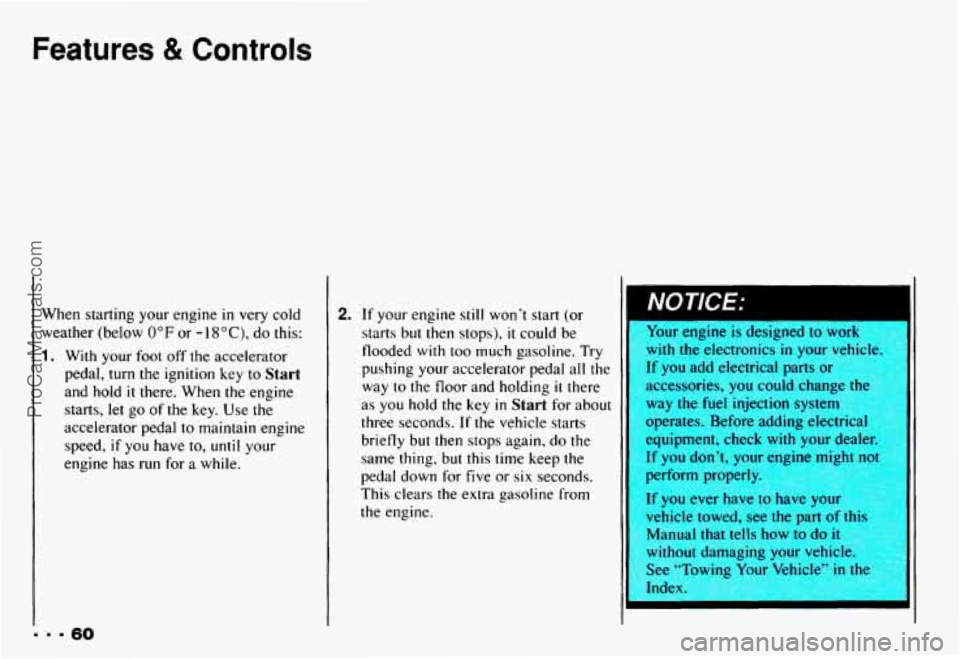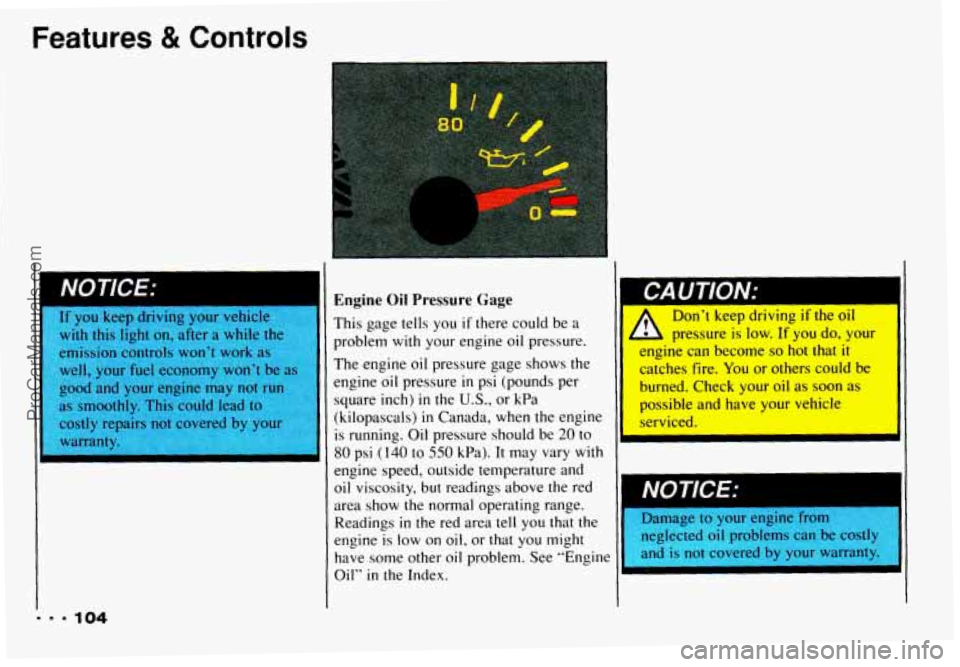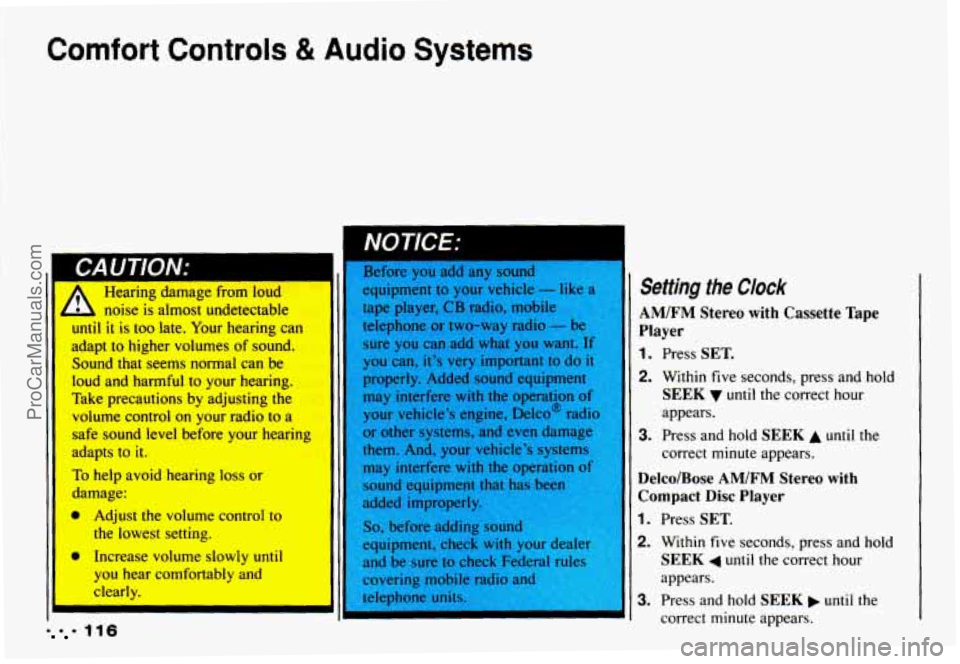1993 CHEVROLET CAMARO check engine
[x] Cancel search: check enginePage 58 of 358

Features & Controls
the engine. If someone tries to start your
vehicle again or uses another key during
this time, the vehicle
will not start. This
discourages someone from randomly
trying different keys
with different
resistor pellets
in an attempt to make a
match.
The ignition key must be clean and dry
before it’s inserted
in the ignition or the
engine may not start. If the engine does
not start and the
SECURITY light stays
on when you try to start the vehicle, the
key may be dirty or wet. Turn the
ignition off.
Zlean and dry the key. Wait about three
ninutes and try again. The
SECURITY
ight will remain on during this time. If the
starter still won’t work, and the key
appears to be clean and dry, wait about three minutes and
try the other ignition
key.
At this time, you may also want to
check the fuses (see “Fuses and Circuit
Breakers”
in the Index). If the starter
won’t work with the other key, your
vehicle needs service. If your vehicle
does start, the first ignition key may
be faulty. See your Chevrolet dealer
or a locksmith who can service the
PASS-Key
II@.
[f you accidentally use a key that has a
lamaged or missing resistor pellet, the
;tarter won’t work and the security light
will flash. But you don’t have to wait
hree minutes before trying one of the
Ither ignition keys. See your Chevrolet
dealer or a locksmith
who can service the PASS-Key II@ to
have a new key made.
If you’re ever driving and the
SECURITY light comes on and stays on,
you
will be able to restart your en ine if
you turn it off. Your PASS-Key I1 %
;ystem, however, is not working properly
md must be serviced by your Chevrolet lealer. Your vehicle
is not protected by
:he PASS-Key 11’ system.
:f you lose or damage a PASS-Key 11’
gnition key, see your Chevrolet
lealer or a locksmith who can service
’ASS-Key 11’ to have a new key made.
ProCarManuals.com
Page 64 of 358

Features 8t Controls
When starting your engine in very cold
weather (below
0°F or - I SOC), do this:
1. With your foot off the accelerator
pedal,
turn the ignition key to Start
and hold it there. When the engine
starts, let go of the key. Use the
accelerator pedal to maintain engine
speed,
if you have to, until your
engine has run for
a while.
2. If your engine still won’t start (or
starts
but then stops), it could be
flooded
with too much gasoline. Try
pushing your accelerator pedal all the
way to the floor and holding
it there
as you hold the key in Start for about
three seconds.
If the vehicle starts
briefly but then stops again, do the
same thing, but this time keep the
pedal down for five or
six seconds.
This clears the extra gasoline from
the engine.
NOTICE:
1 Your engine is designed to work
with the electronics in your vehicle.
If you add electrical parts or
accessories, you could change
th
way the fuel injection system
operates. Before adding electrlcal
equipment, check with your dealer.
II
If you don’t, your engine might not
perform properly.
If you ever have
to have your
vehicle towed, see the part
of thi
Manual that tells how to do it
without damaging your vehicle.
See “Towing Your Vehicle’’
in th
Index
I I
ProCarManuals.com
Page 103 of 358

Trip Odometer
The trip odometer can tell you how far
your vehicle has been driven since you
last set the trip odometer to zero.
To set the trip odometer to zero, press the
knob.
Tachometer
The tachometer displays the engine speed
in thousands of revolutions per minute
(rpm).
NOTICE:
Do not operate the engine with th-
tachometer in the red :are:* nr en~~
damage may occur.
Warning Lights, Gages
and Zndicators
This section describes the warning lights
and gages that are
on your vehicle. The
pictures will help you locate them.
Warning lights and gages can signal that
something is wrong before
it becomes
serious enough
to cause an expensive
repair
or replacement. Paying attention to
your warning lights and gages could also
save you or others from injury.
Warning lights
go on when there may be
or is a problem with one
of your vehicle’s
functions.
As you will see in the details
on the next few pages, some warning
lights come on briefly when
you turn the
ignition key just to let you know they‘re working.
If you
are familiar with this
section,
you should not be alarmed when
this happens.
Gages can indicate when there may be or
is a problem with one of your vehicle’s
functions. Often gages and warning lights
work together to let
you know when
there’s a problem with your vehicle.
When one
of the warning lights comes on
and stays on when you are driving. or
when one
of the gages shows there may
be a problem, check the section that tells
you what
to do about it. Please follow the
manual’s advice. Waiting
to do repairs
can
be costly - and even dangerous. So
please get to know your warning lights
and gages. They‘re
a big help.
ProCarManuals.com
Page 106 of 358

Features 8t Controls
f
I
I
. ’ 102
If the light stays on or comes on when
you’re driving, stop
as soon as possible
and turn the key off. Then start the engine
to reset the system. If the light still stays
on, or comes on again while you’re
driving, your Chevrolet needs service.
Unless the regular brake system warning
light is also on, you
will still have brakes,
but not anti-lock brakes. If the regular
brake system warning
light is also on, see
“Brake System Warning Light” earlier
in
this part. When your anti-lock system is working,
the message
LOW TRAC will appear on
your instrument cluster. This means that
slippery road conditions may exist. Adjust
your driving accordingly. The light
will
stay on for about four seconds after the
ABS stops working. The
LOW TRAC
light also comes on during engine starting
as
a bulb check.
Engine Coolant Temperature Gage
This gage shows the engine coolant
temperature.
If the gage pointer moves
into the red area, your engine is
too hot!
It means that your engine coolant has
overheated. If you have been operating
your vehicle under normal driving
conditions, you should
pull off the road,
stop your vehicle and
turn off the engine
as soon as possible.
HOT COOLANT CAN BURN YOU
BADLY!
In ”Problerns on the Road,” this manual
shows
what to do. See “Engine
Overheating”
in the Index.
ProCarManuals.com
Page 107 of 358

Voltmeter
You can read battery voltage on your
voltmeter. If
it reads less than 1 I volts or
more than
16 volts while your engine is
running, and
it stays there, you may have
a problem with the electrical charging
system. Have
it checked right away.
Driving with the voltmeter reading
in a
warning zone could drain your battery.
If you idle your engine for a while, the
voltmeter reading might move into the
yellow zone.
If the reading stays in the
yellow zone while you are driving, you
may have a problem with
the electrical
charging system. Have
it checked. While
the voltmeter reads
in the yellow zone,
your battery may
not be able to power
certain electrical accessories, like ABS.
(If this happens, your ABS INOP light
will come
on, See "Anti-Lock Brake
System Warning Light"
in this part.)
It' you must drive a short distance with the
voltmeter reading
in a warning zone. turn
off all your accessories, including your
comfort control and audio systems.
Malfunction Ind-kator Lamp
(Service Engine Soon Light)
A computer monitors operation of your
fuel, ignition and emission control
systems. This light should come on when
the ignition is
on, but the engine is not
running, as a check
to show you il is
working.
If it does not come on at all,
have
it fixed right away. If it stays on, or
it comes on while you are driving, the
computer is indicating that you have
a
problem. You should take your vehicle in
for service soon.
ProCarManuals.com
Page 108 of 358

Features & Controls
It you keep driving your vehicle
with this
fight on, after a while
emission controls won’t work
well, your fuel economy won’t be
good and your engine may
not rul
as smoothly. This could lead tc
costly repairs not covered by y
warranty.
... 104
Engine Oil Pressure Gage
This gage tells you if there could be a
problem with your engine oil pressure.
The engine oil pressure gage shows the
engine oil pressure
in psi (pounds per
square inch)
in the U.S., or kPa
(kilopascals)
in Canada, when the engine
is running. Oil pressure should be 20 to
80 psi (140 to 550 kPa). It may vary with
engine speed, outside temperature and
oil viscosity, but readings above the red
area show the normal operating range.
Readings
in the red area tell you that the
engine is
low on oil, or that you might
have some other oil problem. See “Engine
Oil”
in the Index.
Don’t keep driving if the oil
h pressure is low. If you do, your
cllgine can become
so hot that it
I catches fire. You or others could be
burned. Check your
oil as soon as
possible and have your vehicle
serviced.
I NOTICE:
‘I
3
Damage your engine from
neglected oil problems can be costl)
ProCarManuals.com
Page 109 of 358

Check Gages Light
This light will come on briefly when you
are starting the engine.
If the light comes
on and stays
on while you are driving.
check your gages
to see if they are in the
warning areas.
Low Oil Light
This light should come on while you are
starting your engine.
If the light doesn’t
come on. have
it repaired. If the light
comes on while starting your engine and
stays on. your engine
oil level may be too
low. You may need to add oil. See the
Index under “Engine
Oil.“
Low Coolant Light (V8 Engine)
This light should come on while you are
starting your engine.
If the light doesn’t
come on, have
it repaired. The light also
comes on when the coolant
in your
radiator is low.
You may need to add
coolant. See
the Index under “Engine
Coolant.“
.. Drtvlng wilt Lllr uw vv wwvuIIA I’
light on could cause your Chevrolet tc
overheat. See “Engine Overheating”
in the Index. Your Chevrolet could be
damaged, and
it wouldn’t be covered
by your warranty.
ProCarManuals.com
Page 120 of 358

Comfort Controls & Audio Systems
I Setting the Clock noise is almost undetectable AM/FM Stereo with Cassette Tape
until it is too late. Your hearing can
adapt
to higher volumes of sound. sure you can add what you want. If
Player
you can, it’s very important to do it 1. Press SET. Sound that Seems normal can be
Ioud and harmful to your hearing.
Take precautions by adjusting the
volume
control on your radio to a
safe sound level before your hearing
adapts
to it.
To help avoid hearing loss or 31
damage:
a Adjust the volume control to
the lowest setting. properly.
Added
sound equipment
may interfere
with the operation of
your vehicle’s engine, Delco@ radio
or other systems, and even damage
them. And, your vehicle’s systems may interfere
with the operation of
sound equipment that has been
added improperly.
So, before adding sound
equipment, check with your d er
2. Within five
seconds, press and hold
SEEK until the correct hour
appears.
correct minute appears.
3. Press and hold SEEK A until the
Delco/Bose AM/FM Stereo with
Compact Disc Player
1. Press SET.
2. Within five seconds, press and hold
SEEK 4 until the correct hour I, Increase volume slowly until
you
hear comfortably and appears.
clearly. 3. Press and hold SEEK until the
1116 correct minute appears.
ProCarManuals.com